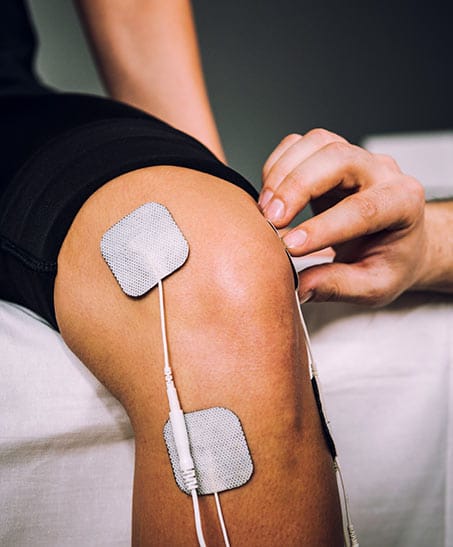Need support? Drop us an email

Interferential current therapy is an effective therapy option used by many physiotherapy clinics to relieve pain and accelerate the self-healing process, getting your body back to a healthy, pain free state. The high frequency signals of an IFC penetrate through the skin into deeper lying muscle tissues. Electrodes are placed on your skin around the injured body part. The Interferential Current device then transmits electrical impulses in minute quantities through your skin. Underlying tissue and nerves are stimulated which begins the healing properties. These impulses are not painful in the least. In fact, patients describe the sensation as a minor prickle on their skin. Frequencies produced by the IFC have been proven to stimulate endorphins, the body’s natural pain killers. This can help to create a self-healing process without the need to for medications. This form of therapy is also extremely useful in reducing pain, inflammation, oedema(swelling), and spasms.
How the Interferential Current Therapy Helps
Interferential Current stimulation is very useful in the treatment of circulatory and muscular disorders, stiffness of joints, oedema, and inflammation. If you suffer from health problems such as cumulative trauma disorders, body pain, joint injuries, or are pre or post orthopaedic surgery, interferential current therapy is an important option.
There have been numerous case studies and research reports that have documented IFTs versatility in treating diverse symptoms, accelerating the healing process and restoring normal movement. It also helps in blood circulation and hastens the healing process by stimulating endorphins.
Interferential current therapy is an effective therapy option used by many physiotherapy clinics to relieve pain and accelerate the self-healing process, getting your body back to a healthy, pain free state. The high frequency signals of an IFC penetrate through the skin into deeper lying muscle tissues.


Therapeutic ultrasound is a modality that has been used by physiotherapists since the 1940s. Ultrasound is applied using the head of an ultrasound probe that is placed in direct contact with your skin via a transmission coupling gel. Therapeutic ultrasound has been shown to cause increases in:
The effect of ultrasound via an increase in local blood flow can be used to help reduce local swelling and chronic inflammation, and, according to some studies, promote bone fracture healing. The intensity or power density of the ultrasound can be adjusted depending on the desired effect. A greater power density (measured in watt/cm2) is often used in cases where scar tissue breakdown is the goal.
Ultrasound can also be used to achieve phonophoresis. This is a non-invasive way of administering medications to tissues below the skin; perfect for patients who are uncomfortable with injections. With this technique, the ultrasonic energy forces the medication through the skin. Cortisone, used to reduce inflammation, is one of the more commonly used substances delivered in this way.
What is an Ultrasound Dose?
A typical ultrasound treatment will take from 3-5 minutes. In cases where scar tissue breakdown is the goal, this treatment time can be much longer. During the treatment the head of the ultrasound probe is kept in constant motion. If kept in constant motion, the patient should feel no discomfort at all.
Some conditions treated with ultrasound include tendonitis (or tendinitis if you prefer), non-acute joint swelling and muscle spasm.
How Does an Ultrasound Work?
The ultrasound waves are generated by a piezoelectric effect caused by the vibration of crystals within the head of the probe. The ultrasound waves that pass through the skin cause a vibration of the local soft tissues. This vibration or cavitation can cause a deep heating locally though usually no sensation of heat will be felt by the patient. In situations where a heating effect is not desirable, such as a fresh injury with acute inflammation, the ultrasound can be pulsed rather than continuously transmitted.
Contraindications of ultrasound include local malignancy, metal implants below the area being treated, local acute infection, vascular abnormalities, and directly on the abdomen of pregnant women. It is also contraindicated to apply ultrasound directly over active epiphyseal regions (growth plates) in children, over the spinal cord in the area of a laminectomy, or over the eyes, skull, or testes.
Like all medical equipment, when used by highly trained professionals such as your physiotherapist, therapeutic ultrasound is very unlikely to cause any adverse effects. Please consult your physiotherapist for their expert opinion on the best use of therapeutic ultrasound and your injury.
Need support? Drop us an email
We are open on
Copyright © 2022 Craniaa Neuro Rehab Centre
Designed & Developed by AdMedia Technologies